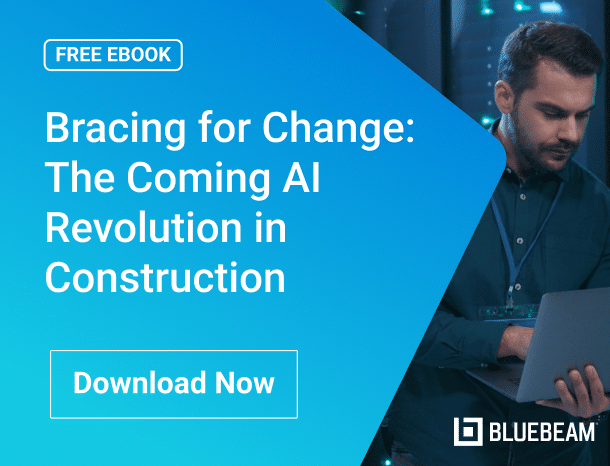For more than a century, oil fueled the growth of the global economy. But today, a new power source is rising to prominence—and reshaping the built world along the way.
Electricity, not oil, is now the backbone of economic expansion in the United States and around the world. With demand surging due to rapid growth in data centers, electric vehicles (EVs), domestic manufacturing and renewable energy infrastructure, the spotlight is shifting toward the systems and structures needed to generate, transmit and store electricity at scale.
This transformation puts the construction industry at the center of the energy transition. But unlike past infrastructure booms, the new wave of energy projects requires far more than steel and concrete. To succeed, it depends on highly connected, collaborative teams—and digital tools that can keep everyone aligned, efficient and compliant from planning to final inspection.
A New Energy Economy Emerges
After decades of relatively flat energy consumption, electricity demand in the US is climbing fast—and it’s not expected to slow down. A recent Wall Street Journal article noted that demand is being driven by a confluence of factors: the rapid rise of artificial intelligence, a growing fleet of EVs, expansion of domestic manufacturing under the Inflation Reduction Act and CHIPS Act, and a broader push to electrify everything from water heaters to home heating systems.
……
Key Infrastructure Driving the Transition
What Projects Are Powering the Electric Economy?
As electricity becomes the new backbone of economic growth, a wave of complex infrastructure projects is reshaping the built environment. These are the critical developments driving the shift:
- Utility-Scale Solar and Wind Farms: Large-scale renewable energy projects are being deployed across rural and coastal areas to meet rising demand with clean, sustainable power.
- High-Voltage Transmission and Grid Interconnection Upgrades: Modernizing the electrical grid requires new transmission lines, substations and interconnection points to distribute power efficiently and reliably.
- EV Charging Networks: Extensive charging infrastructure is expanding along highways and in urban areas to support the growing number of electric vehicles on the road.
- Hydrogen Production and Clean Energy Manufacturing Plants: New industrial facilities focused on low-carbon hydrogen and advanced clean-tech manufacturing are being built to support decarbonization goals.
- Data Centers for Cloud and AI: The explosion of AI and digital services is fueling demand for energy-intensive data centers—many of which require dedicated grid infrastructure.
These projects depend on close coordination between public agencies, utilities and construction teams—and digital tools to keep them on track.
……
One of the most telling examples is the planned expansion by Dominion Energy, which is set to double its electricity generation capacity over the next 15 years to keep up with demand—much of it concentrated around Northern Virginia’s booming data center corridor, nicknamed “Data Center Alley.”
Meanwhile, a 2024 report from the Electric Power Research Institute (EPRI) projected that total US electricity demand could grow by up to 76% by 2050, depending on the pace of electrification and technology adoption. Demand from industrial consumers—such as semiconductor fabs and hydrogen production facilities—is projected to be especially strong.
This growth comes with major implications for utilities, public agencies, construction firms and energy developers alike: The need to modernize and expand America’s electrical grid has never been more urgent.
Construction’s Critical Role
Whether it’s building utility-scale solar and wind farms, EV charging networks, grid interconnection points or high-voltage transmission lines, construction professionals are on the front lines of the shift toward an electrified economy.
These projects are often highly complex, involving dozens of stakeholders: contractors, engineers, utility companies, permitting officials, environmental consultants and municipal governments. They must meet stringent safety, compliance and sustainability requirements while staying on budget and schedule—a challenge that grows exponentially when teams are spread across disciplines and geographies.
Today’s energy infrastructure projects also differ from traditional builds in another crucial way: they’re expected to be both fast and future-proof. That means coordinating timelines with grid capacity upgrades, ensuring interoperability with emerging technologies and staying ahead of changing regulatory frameworks.
In this high-stakes environment, effective communication and coordination aren’t just nice to have; they’re essential to keeping projects on track and delivering long-term value.
Delays and Disconnection: A Growing Concern
Despite the growing urgency of energy transition projects, permitting delays and bureaucratic bottlenecks continue to stall progress.
According to data from Berkeley Lab, the median wait time for new power sources to connect to the grid reached five years in 2023, the most recent year for which data is available. The interconnection process—essentially, getting permission to connect a power source to the grid—has become a major roadblock, especially for solar and wind developers.
Many projects also face challenges during the planning and design phases, where traditional, paper-heavy workflows and siloed teams make it difficult to respond quickly to feedback or maintain a single source of truth.
From markups lost in email threads to outdated drawings floating between teams, the cost of miscommunication can be enormous—especially on infrastructure projects that require careful regulatory oversight and precise technical coordination.
Why Connected Teams—and Tools—Matter
As the pace and complexity of energy infrastructure projects accelerates, connected construction workflows are becoming a critical advantage. Platforms like Bluebeam offer centralized tools for design review, permitting coordination, documentation, compliance and real-time communication.
For example, Bluebeam Revu allows construction professionals to:
- Speed up permitting and plan reviews by enabling real-time markups, standardized workflows and easier collaboration with agencies and reviewers.
- Maintain version control and reduce rework by tracking changes and comments across disciplines and stakeholders.
- Ensure audit-ready documentation for inspections, regulatory compliance and project closeout.
- Access and update plans remotely, helping distributed teams work more efficiently and transparently.
In an environment where even small delays can have cascading effects—from missed tax credits to regional energy shortages—teams that can work faster and smarter have a distinct edge.
Supporting Both the Private and Public Sectors
One of the unique challenges of energy infrastructure is the need to bridge the gap between private development and public oversight. While utilities and developers are often responsible for design and construction, permitting and regulatory review are handled by local, state and federal agencies.
That’s why connected platforms like Bluebeam aren’t just for contractors but are equally valuable for public-sector partners managing plan review, compliance documentation and interagency collaboration.
By streamlining communication between public agencies and private stakeholders, Bluebeam helps shorten timelines, reduce confusion and keep critical infrastructure projects moving forward.
The Broader Sustainability Opportunity
The shift to electricity isn’t just about supply and demand. It’s also about reducing emissions and improving sustainability across the built environment.
By helping teams work digitally, Bluebeam supports broader environmental goals:
- Reducing paper usage and printing costs.
- Minimizing travel to jobsites or city offices for plan reviews.
- Improving project outcomes through better coordination and reduced waste.
These benefits align closely with the goals of many energy developers, municipalities and design firms aiming to meet ESG targets and reduce the environmental impact of construction itself.
Building the Grid of the Future
As oil’s dominance fades and the electric economy takes shape, construction professionals will continue to play a leading role in shaping the built environment.
But the demands of this new era require new ways of working—ones built on digital collaboration, real-time transparency and integrated data.
By enabling connected teams to plan, build and manage projects more effectively, Bluebeam helps lay the foundation for a faster, cleaner and more resilient energy future. It’s not just about tools—it’s about empowering the people and processes that will make the energy transition real.
Ready to power your next project with smarter collaboration?























